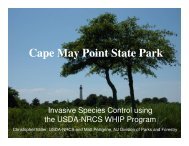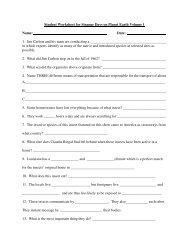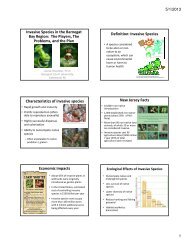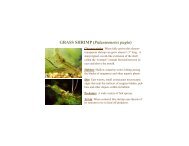Norway Maple (Acer platanoides) Japanese Barberry (Berberis ...
Norway Maple (Acer platanoides) Japanese Barberry (Berberis ...
Norway Maple (Acer platanoides) Japanese Barberry (Berberis ...
Create successful ePaper yourself
Turn your PDF publications into a flip-book with our unique Google optimized e-Paper software.
Burdock (Arctium minus)<br />
Status: Exotic.<br />
Native to: Europe.<br />
Effects: Indirectly affects the development of crops by<br />
hosting powdery mildew and root rot. Reduces value of<br />
sheep’s wool when its seed heads get entangled in it.<br />
http://www.raems.com/edibles/burdock2.jpg<br />
Distinctive features: In its first year of growth this<br />
plant grows as a rosette near the ground. Then, in the<br />
second year, it sends up a stout, grooved, rough stem<br />
with multiple branches that grow 2-6 feet tall. The<br />
large, heart-shaped leaves are dark green and smooth<br />
above and whitish green underneath. They attach to the<br />
stem alternately rather than opposite one another. This<br />
plant produces numerous pink, purple or white flowers<br />
clustered together in flowering heads that are about ¾<br />
inch across. Each head is enclosed in a prickly burr with<br />
numerous hooked spines on its tips. This plant flowers<br />
between July and October.<br />
Queen Anne’s Lace (Daucus carota)<br />
Status: Exotic.<br />
Native to: Europe.<br />
Effects: Because it spreads rapidly by seed and springs<br />
back after mowing, this biennial plant is considered a<br />
serious pest in some states.<br />
http://www.naturephoto-cz.eu/pic/bilek/daucus-carota-l.-subsp.-<br />
carota-0192.jpg<br />
Distinctive features: A close relative to the domestic<br />
carrot, this plant’s leaves look very similar. The first<br />
year, the leaves form a rosette, then the second year a<br />
coarsely hairy flowering stem is produced that can grow<br />
to more than 3 ft. in height. Leaves sprouting from the<br />
flowering stems are alternate. A flat-topped cluster of<br />
small, white flowers forms at the top of the stem. The<br />
presence of a single reddish purple flower in the middle<br />
of this cluster is distinctive of the species, but is not<br />
always present. A similar-looking member of this plant<br />
family, Poison Hemlock, has grooved, purple-spotted<br />
stems and is hairless.







